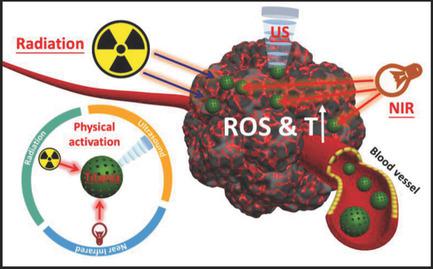Our official English website, www.x-mol.net, welcomes your feedback! (Note: you will need to create a separate account there.)
Exogenous Physical Irradiation on Titania Semiconductors: Materials Chemistry and Tumor‐Specific Nanomedicine
Advanced Science ( IF 15.1 ) Pub Date : 2018-10-17 , DOI: 10.1002/advs.201801175 Ruifang Zhang 1 , Fei Yan 2 , Yu Chen 3
Advanced Science ( IF 15.1 ) Pub Date : 2018-10-17 , DOI: 10.1002/advs.201801175 Ruifang Zhang 1 , Fei Yan 2 , Yu Chen 3
Affiliation

|
Titania semiconductors can be activated by external physical triggers to produce electrons (e−) and holes (h+) pairs from the energy‐band structure and subsequently induce the generation of reactive oxygen species for killing cancer cells, but the traditional ultraviolet light with potential phototoxicity and low‐tissue‐penetrating depth as the irradiation source significantly hinders the further in vivo broad biomedical applications. Here, the very‐recent development of novel exogenous physical irradiation of titania semiconductors for tumor‐specific therapies based on their unique physiochemical properties, including near infrared (NIR)‐triggered photothermal hyperthermia and photodynamic therapy, X‐ray/Cerenkov radiation‐activated deep‐seated photodynamic therapy, ultrasound‐triggered sonodynamic therapy, and the intriguing synergistic therapeutic paradigms by combined exogenous physical irradiations are in focus. Most of these promising therapeutic modalities are based on the semiconductor nature of titania nanoplatforms, together with their defect modulation for photothermal hyperthermia. The biocompatibility and biosafety of these titania semiconductors are also highlighted for guaranteeing their further clinical translation. Challenges and future developments of titania‐based therapeutic nanoplatforms and the corresponding developed therapeutic modalities for potential clinical translation of tumor‐specific therapy are also discussed and outlooked.
中文翻译:

二氧化钛半导体上的外源物理辐射:材料化学和肿瘤特异性纳米医学
二氧化钛半导体可以被外部物理触发激活,从能带结构中产生电子(e -)和空穴(h + )对,随后诱导活性氧的产生来杀死癌细胞,但传统的紫外线具有潜在的潜力作为照射源的光毒性和低组织穿透深度严重阻碍了进一步在体内广泛的生物医学应用。在此,基于其独特的理化特性,最近开发了用于肿瘤特异性治疗的新型外源物理照射二氧化钛半导体,包括近红外(NIR)触发的光热疗法和光动力疗法、X射线/切伦科夫辐射激活的深层疗法坐位光动力疗法、超声触发声动力疗法以及结合外源物理照射的有趣的协同治疗范例是焦点。这些有前途的治疗方式大多数都是基于二氧化钛纳米平台的半导体性质及其对光热热疗的缺陷调节。这些二氧化钛半导体的生物相容性和生物安全性也受到重视,以保证其进一步的临床转化。还讨论和展望了基于二氧化钛的治疗纳米平台的挑战和未来发展以及相应开发的肿瘤特异性疗法潜在临床转化的治疗方式。
更新日期:2018-10-17
中文翻译:

二氧化钛半导体上的外源物理辐射:材料化学和肿瘤特异性纳米医学
二氧化钛半导体可以被外部物理触发激活,从能带结构中产生电子(e -)和空穴(h + )对,随后诱导活性氧的产生来杀死癌细胞,但传统的紫外线具有潜在的潜力作为照射源的光毒性和低组织穿透深度严重阻碍了进一步在体内广泛的生物医学应用。在此,基于其独特的理化特性,最近开发了用于肿瘤特异性治疗的新型外源物理照射二氧化钛半导体,包括近红外(NIR)触发的光热疗法和光动力疗法、X射线/切伦科夫辐射激活的深层疗法坐位光动力疗法、超声触发声动力疗法以及结合外源物理照射的有趣的协同治疗范例是焦点。这些有前途的治疗方式大多数都是基于二氧化钛纳米平台的半导体性质及其对光热热疗的缺陷调节。这些二氧化钛半导体的生物相容性和生物安全性也受到重视,以保证其进一步的临床转化。还讨论和展望了基于二氧化钛的治疗纳米平台的挑战和未来发展以及相应开发的肿瘤特异性疗法潜在临床转化的治疗方式。


























 京公网安备 11010802027423号
京公网安备 11010802027423号